|
 |
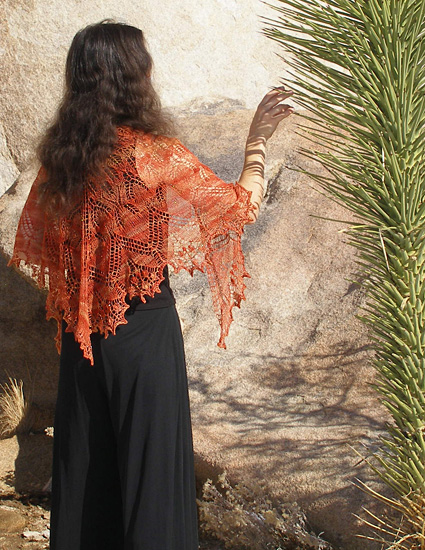 |
|
 model: Elizabeth
Freeman model: Elizabeth
Freeman  photos: Sylvia Hilsinger, Janice Freeman, Elizabeth Freeman photos: Sylvia Hilsinger, Janice Freeman, Elizabeth Freeman |
by Elizabeth Freeman

In the Mohave desert, the aeolian
erosion from millennia
of wind driven sand has carved a landscape of curving
organic sculpture from desert rock that is home to
cactus, yucca, and the twisting forms of Joshua Trees.
The curves of the rock, the repetitive geometries of
the yucca stalks and agave leaves, and the brief but
extravagant blossoms of the desert after a rain are
all echoed in this lace.
The desert embraces both
slow, subtle beauty and over-the-top extravagance. Blazing
heat and drifting snow.
In this design, I combine the
slow patience of lace
knitting, and the profligate abandon of the desert
after a storm. Nupps and beads?
Why not!
|
|
Shoulderette[Shawl] |
Handspun Flame Shoulderette
Length at center back: 27 inches
Width: 64 inches
Purple Shoulderette
Length at center back: 23 inches
Width: 48 inches
Silver Cream Shawl
Length at center back:
38 inches
Width: 90 inches |
| |
Handspun Flame
Shoulderette
 Handspun
Blue Faced Leicester [100%
Blue Faced Leicester; approximately
500yd/457m and 2oz/57g skein,
35wpi]; color: yellow food
coloring, Mexican Kool-Aid
in Jamaica (Hibiscus) and Tamarindo Handspun
Blue Faced Leicester [100%
Blue Faced Leicester; approximately
500yd/457m and 2oz/57g skein,
35wpi]; color: yellow food
coloring, Mexican Kool-Aid
in Jamaica (Hibiscus) and Tamarindo
Recommended
needle size:
 1
US 5/3.75mm circular needle,
24 inches or longer 1
US 5/3.75mm circular needle,
24 inches or longer
[always use a needle size that gives you the gauge listed below -- every
knitter's gauge is unique]

Purple Shoulderette
 Misti
Alpaca Lace [100% Baby
Alpaca; 437yd/400m per 50g skein]; color: Merlot; 1 skein Misti
Alpaca Lace [100% Baby
Alpaca; 437yd/400m per 50g skein]; color: Merlot; 1 skein
Note: The shoulderette
shown required approx.
430yd/395m. Buy a second
skein to be safe.
Recommended needle
size
 1
US 4/3.5mm circular needle,
24 inches or longer 1
US 4/3.5mm circular needle,
24 inches or longer
[always use a needle size
that gives you the gauge listed below -- every knitter's gauge
is unique]

Silver Cream Shawl
 Habu
XS-45 20/3 bamboo [100% bamboo; 574yd/513m per 48g skein];
color: 2; 2 skeins Habu
XS-45 20/3 bamboo [100% bamboo; 574yd/513m per 48g skein];
color: 2; 2 skeins
Note: Shawl required approx. 1100yd/1000m.
Recommended needle size:
 1
US 2/3.0mm circular needle,
32 inches or longer 1
US 2/3.0mm circular needle,
32 inches or longer

For
all versions:
 Approx.
850[2250] beads, size 8 Approx.
850[2250] beads, size 8
 Crochet hook in size close
to needle size (used for provisional cast on only) Crochet hook in size close
to needle size (used for provisional cast on only)
 Steel crochet hook small
enough to fit through holes of beads (I used size 14 / 0.75mm) Steel crochet hook small
enough to fit through holes of beads (I used size 14 / 0.75mm)
 Waste yarn Waste yarn
 Stitch markers Stitch markers
 Smooth string or yarn,
or blocking wires Smooth string or yarn,
or blocking wires
 Rust-proof pins Rust-proof pins
|
| |
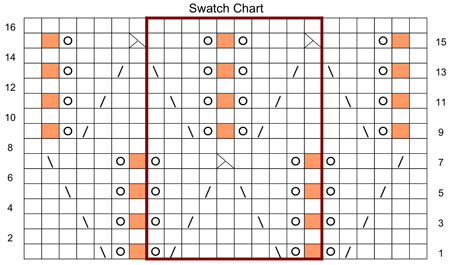 Gauge
is measured over Swatch Chart
(based on Yucca pattern).
Correct gauge is not essential for this project unless you
are working with a limited quantity of yarn (ie. if you are
working the Shoulderette as written using only 1 skein of
the yarn listed). However, if you do wish to swatch and measure
your gauge before beginning, use the Swatch Chart provided
at right. Block swatch, allow to dry, unpin and allow to relax
before measuring gauge. Gauge
is measured over Swatch Chart
(based on Yucca pattern).
Correct gauge is not essential for this project unless you
are working with a limited quantity of yarn (ie. if you are
working the Shoulderette as written using only 1 skein of
the yarn listed). However, if you do wish to swatch and measure
your gauge before beginning, use the Swatch Chart provided
at right. Block swatch, allow to dry, unpin and allow to relax
before measuring gauge.
Handspun
Flame Shoulderette: 15
sts/27 rows = 4 inches
on US #5/3.75mm needles
Purple Shoulderette: 18 sts/32 rows = 4 inches on US #4/3.5mm
needles
Silver Cream Shawl: 18 sts/30 rows
= 4 inches on US #2/3.0mm needles |
| |
[Knitty's list of standard abbreviations and techniques can be found here.] |
This pattern is modular.
If you wish to change the
size, you can do so by
varying the number of repeats of the Yucca chart and Agave
chart. Keep the following things in mind:
- The Yucca chart
must be worked an even
number of times (ie. twice,
six times) before working
the Transition chart.
- The
Agave chart may be
worked any number of
times before working the Final Agave
chart.
- The Edging section
requires a surprising
quantity of yarn. For
the silver cream shawl,
the edging and bind-off
required 45% of the yarn. For the smaller shoulderette,
the edging required 65% of the yarn!
If you are using stitch markers between each pattern repeat
to keep track of the lace pattern, note that there will
be points in some charts where decreases within the pattern
will necessitate moving the markers.
Estonian Stitches
This shawl was inspired
by three stitch patterns
from Pitsilised Koekirjad,
an Estonian stitch dictionary.
This book does not give
names for individual stitch patterns. Here I refer to
them by desert plants they resemble. I modified the original
stitch designs so that the repeat lengths match and the
patterns flow from one stitch to the next. For an excellent
description of Estonian lace stitches, see this
site.
For more examples of the
beautiful stitches originating
in Estonia, take a look
at the Estonian
Lace Study. For a history of Estonian
lace knitting, as well
as beautiful Estonian
shawls, both traditional
and contemporary, see Knitted
Lace of Estonia: Techniques,
Patterns, and Traditions, by
Nancy Bush.
Crochet Cast-On
Using waste yarn, work
a crochet chain several sts longer than the number of
sts to be cast on. Starting 1 or 2 sts in from end of
chain and using working yarn, pick up and k 1 st in the
back loop of each ch until the required number of sts
have been picked up. Later, the chain will be unraveled
and the resulting live sts picked up.
K3tog: Knit next 3 sts together.
Sssk: Slip next 3 sts knitwise,
one at a time, to right needle. Insert left needle into
fronts of these 3 sts and knit them together.
S2KP: Slip next 2 sts together,
knitwise, as if to work a k2tog. Knit next st through back
loop, then pass both slipped sts over st just knit. This
forms a centered double decrease.
sk2p: Slip 1 knitwise,
k2tog, pass slipped st over. 2 sts decreased.
Nupps: 7-stitch or 9-stitch
nupps may be worked for this shawl. Try swatching each kind
to see which type works best for the yarn you choose.
Nupp (7-stitch – used in Purple Shoulderette): K1
without dropping st from left needle, yo, [k same st again
without dropping from left needle, yo] 2 times, k same st
again and drop st from left needle. 1 st increased to 7
sts. On following WS row, purl these 7 sts together.
Nupp (9-stitch – used in Handspun Flame Shoulderette
and Silver Cream Shawl): K1 without dropping st from left
needle, yo, [k same st again without dropping from left
needle, yo] 3 times, k same st again and drop st from left
needle. 1 st increased to 9 sts. On following WS row, purl
these 9 sts together.
In a non-elastic yarn such as bamboo, it is particularly
important to make the Nupp
increase stitches very
loosely; the stitches should
be approx. 0.5 inch long.
It helps to use a finger
to hold each new stitch
in place so that you do
not inadvertently tighten
the last increase while
making the next one. On
the WS row, when you insert
the right hand needle to
purl the stitches together,
if you have made the stitches
loose enough, not only
should it be easy to insert
the needle, you should
be able to see space between
the two needles. See the
images below:
Placing Beads: The beads are placed on RS rows using a
very narrow steel crochet
hook. To place a bead on
a stitch, first insert the hook through the hole in the
bead, and slide the bead onto the shaft of the hook. Slip
the stitch off the needle and onto the hook, slide the bead
down the hook and onto the stitch. Slip the stitch back
to the needle, then knit it. Detailed directions can be
found here.
Placing Beads on Decreases: When a bead is to be placed
on a decrease, the bead should be placed before working
the decrease, as follows:
For a [ssk], place the
bead on the first st on the left needle.
For a [k2tog], place the
bead on the second st on the left needle.
For a [S2KP], place the
bead on the second st on the left needle.
Pattern repeats when working
from charts: The set-up chart shows all stitches as knitted.
In the other charts, the pattern repeat is outlined in red.
Knit the stitches to the right of the outlined pattern repeat,
repeat the stitches between the red lines until just enough
stitches remain before the center stitch marker to finish
by knitting the stitches to the left of the outlined pattern
repeat. Repeat on second side of the shawl.
Directions for blocking
a lace shawl may be found here.
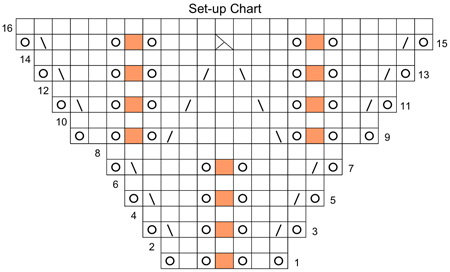
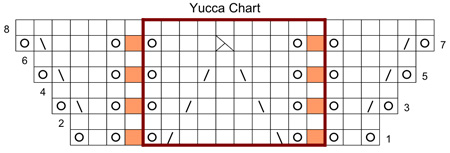

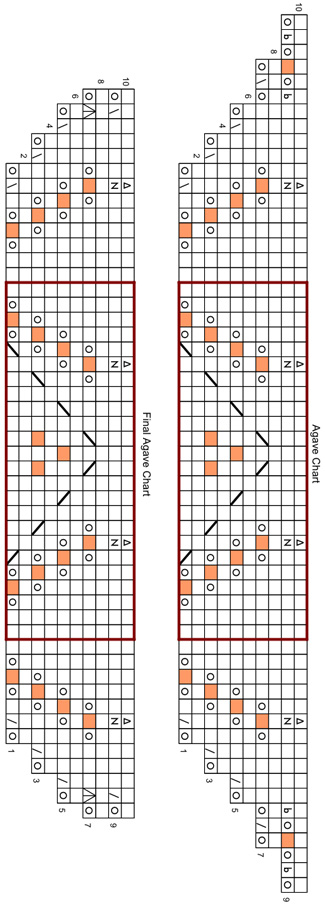 
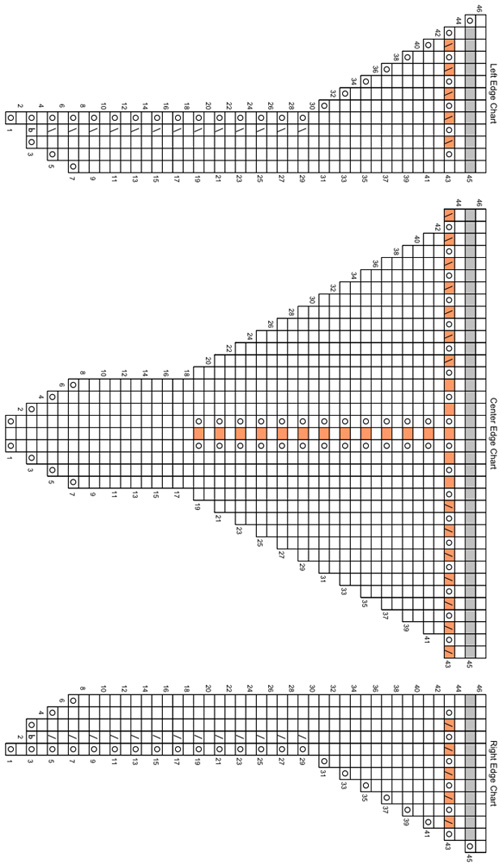
 
|
|
Note: The first st of each row is slipped purlwise. Bring
the yarn between the needles to the back of the work before
knitting the next st.
Using Crochet Cast On, CO 2[3] sts.
K 17 rows, slipping first
st of each row.
At end of last row, turn work 90 degrees clockwise and
pick up and k 7 sts along one long edge of work – this
will be 1 st in each slipped st along edge, skipping
first st.
Remove waste yarn from
CO edge, placing resulting 2[3] live sts on left needle;
k these sts. 11[13] sts.
Next Row [RS]: Sl 1, k1[2], work first row of Set-Up Chart,
place marker, k1 tbl, place marker, work first row of Set-Up Chart, k2[3].
19[21] sts.
The markers now in place
indicate the center st of the shawl. From this point
until beginning the edging, k this st tbl on RS rows,
and p it on WS rows.
The 2[3] sts at each edge
are the border sts; work these sts in garter st. Always
slip the first st of each row.
Note: It is important to
keep the slipped edge sts very loose, so the shawl will
block properly. Don't worry if they look loose and sloppy
before blocking.
Work Rows 2-16 of Set-Up
Chart, working center st and edge sts as set. 51[53]
sts when Set-Up Chart is complete.
Continue as follows, working center st and edges sts
as set.
Work Rows 1-8 of Yucca
Chart 4[12] times. 131[293] sts.
Work Rows 1-18 of Transition
Chart. 219[413] sts.
Shawl Only:
Work Rows 1-10 of Agave
Chart twice. 509 sts.
Shoulderette and Shawl:
Work Rows 1-10 of Final
Agave Chart. 247[537] sts. There are 5[11] Agave motifs
in each half of the shawl.
Next Row [RS]: Sl 1, k1[2], work Row 1 of Right Edge
Chart, place marker, work Row 1 of Edge Set-up Chart,
slip marker, work Row 1 of Center Edge Chart, slip marker,
work Row 1 of Edge Set-up Chart, place marker, work Row
1 of Left Edge Chart, k2[3].
This row sets pattern for
edging. Continue in pattern, working through charts as
established, until Row 28 of Edge Set-up Chart is complete.
Continue working Right, Center and Left Edge Charts
as set, working Rows 29-46
of Main Edge Chart in place
of Set-up Edge Chart. 525[983]
sts.
BO Row [RS]: Using 2 strands of yarn held together,
p2, [sl both sts back to left needle and p2tog, p1] to
last st, sl both sts back to left needle and p2tog. Break
yarn and draw through last st. |
Weave in ends.
Following directions,
block shawl, first pinning out the center point of all the edging flower
motifs, then going back and pinning out four additional points in each
motif, in the edge stitches directly above the nupps (two points on either
side of each flower center). For the spine flower, pin out points every
other bead. The shawl will block to slightly more than a triangle.
Allow
shawl to dry completely
before unpinning.
|
| |
Elizabeth Freeman counts trees and crunches numbers for a living, and has been known to bring her lace knitting along on wilderness backpacking trips |
| Pattern & images © 2009
Elizabeth Freeman. Contact Elizabeth |
|

 Gauge
is measured over Swatch Chart
(based on Yucca pattern).
Correct gauge is not essential for this project unless you
are working with a limited quantity of yarn (ie. if you are
working the Shoulderette as written using only 1 skein of
the yarn listed). However, if you do wish to swatch and measure
your gauge before beginning, use the Swatch Chart provided
at right. Block swatch, allow to dry, unpin and allow to relax
before measuring gauge.
Gauge
is measured over Swatch Chart
(based on Yucca pattern).
Correct gauge is not essential for this project unless you
are working with a limited quantity of yarn (ie. if you are
working the Shoulderette as written using only 1 skein of
the yarn listed). However, if you do wish to swatch and measure
your gauge before beginning, use the Swatch Chart provided
at right. Block swatch, allow to dry, unpin and allow to relax
before measuring gauge.








